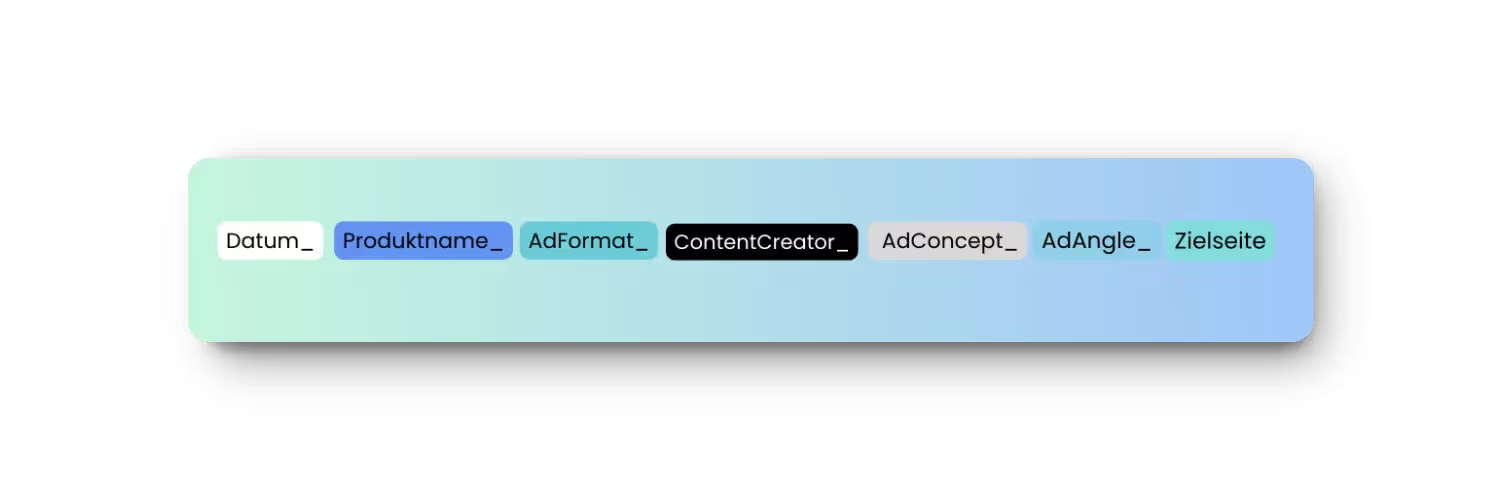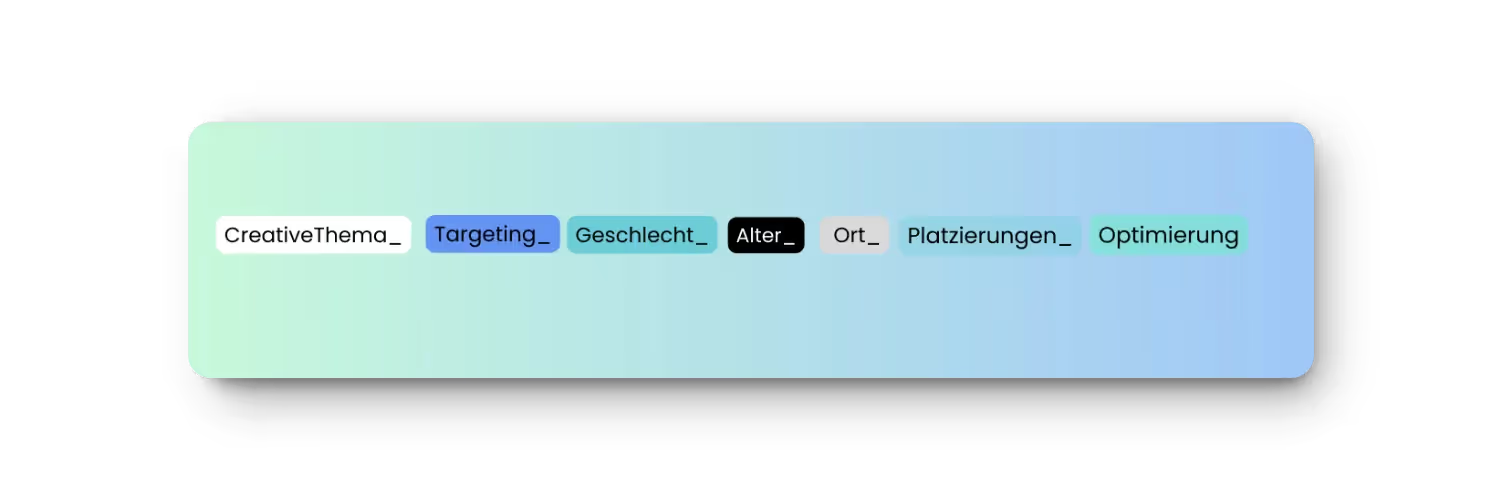The perfect Naming Convention for your Facebook & TikTok Ads
A clean naming convention is the cornerstone of a well-structured ad account. It gives you instant clarity, makes cross-team collaboration smoother, and speeds up analysis and iteration.
In this guide, you’ll learn what a good naming convention looks like and the exact structures we recommend for Facebook Ads and TikTok Ads.
💡 Key Take-Away
Ad name: Date | ProductName | AdFormat | ContentCreator | AdConcept | ADangle | Landing Page (Link to the DatAds template)
Adset name: CreativeTopic | Targeting | Gender | Age | Location | Rankings | Optimization
Campaign name: Funnel level | year | month | bidding strategy | creativestyle/campaign name/product | optimization
Meta UTMs: ? utm_source=meta&utm_medium=cpm&utm_campaign= {{campaign.name}} &utm_content= {{ad.id}} &utm_placement= {{placement}}
TikTok UTMs:? utm_source=tiktok&utm_medium=_cpm&utm_campaign=CAMPAIGN_NAME&utm_content=CID
What is a Naming Convention?
A naming convention is a standardized schema for naming campaigns, ad sets/ad groups, and ads across platforms like Meta (Facebook/Instagram) and TikTok. With a clear, consistent structure, anyone on the team can understand settings at a glance—without opening each asset. This becomes critical as you scale spend, teams, and tests.
Why a good naming convention is crucial
Our Recommended Naming Convention
(Ad/Creative Level)
A precise ad-level naming convention prevents duplicate tests and unlocks cross-campaign creative insights. Describe the creative, copy angle, and landing page directly in the ad name.
You can find the latest best practice, including a template from DatAds here.
For example, you could name your ads like this:

Date | ProductName | AdFormat | ContentCreator | AdConcept | AdAngle | Landing Page
e.g. 23-01-23 | Protein powder | Video | Marie | USVSthem | Protein percentage | PDP
Every part of the naming convention serves a clear purpose:
- Date: Helps you quickly identify when the creative was launched.
- Product Name: Ensures fast attribution to the promoted product.
- Ad Format: Differentiates formats such as image, video, carousel, etc.
- Content Creator: Identifies who produced the ad (e.g., UGC creator, agency, or in-house team).
- Ad Concept: Describes the overall approach or style of the creative.
- Ad Angle: Captures the core message or unique selling point.
- Landing Page: Shows where the ad directs traffic (e.g., landing page, PDP, collection page).
You can expand your Facebook Ads or TikTok Ads naming convention with additional identifiers if needed. For example:
- Differentiate between UGC vs. studio-shot videos.
- Add the Awareness Stage (Problem, Solution, Product Awareness) if the funnel complexity requires it.
The key is to include only the components that matter most to your testing and scaling process—without introducing unnecessary complexity.
This is why we recommend the structure above. In particular, always capture the creative angle or the overarching creative concept at the ad level. This allows you to analyze, over time, which angles and concepts consistently perform best across campaigns.
Ad set level
At the ad set level (Facebook) or ad group level (TikTok), the goal is to clearly describe your targeting and audience settings. This ensures anyone on your team can instantly understand who you’re targeting—without opening the platform UI.
If you’re using ABO (Ad Set Budget Optimization), it’s smart to include an indicator of the creative(s) running inside this ad set. That way, reporting and troubleshooting become much faster.

CreativeTopic | Targeting | Gender | Age | Location | Rankings | Optimization
e.g. WheyProtein 20% Offer | Open Targeting | Men | 21+ | DACH |AllPlacements | PUR
Each element of the ad set (or ad group) name has a specific role:
- Creative Topic: The overarching theme of the creatives inside the ad set (e.g., product benefits, testimonials, seasonal offer).
- Targeting: Define the targeting type, such as Lookalike audiences, Broad/Open targeting, or Interest targeting.
- Gender: Specify the gender your ads should reach—Female, Male, or All.
- Age: Always add the age range of your audience.
- Location: Include the countries or regions you’re targeting. For example, “DACH” (Germany, Austria, Switzerland) or even single cities if running local campaigns.
- Placement: Note whether you’re using all placements or testing specific ones, like “IG Reels” or “TikTok In-Feed.”
- Optimization Event: Clearly state the conversion event you’re optimizing for, such as Purchase, Add-to-Cart, or Lead.
By keeping each of these identifiers in your ad set naming convention for Facebook Ads and TikTok Ads, you’ll be able to instantly recognize the targeting setup, spot differences between ad sets, and make faster optimizations.
Campaign level
At the campaign level, you should be able to understand what this campaign is basically about. In other words, the higher-ranking goal, as well as the strategy behind it, should be clearly recognizable. For example, your campaign name could look like this:

e.g. Prospecting | 2025 | 01 | | AGM | DACH | Testing | SUBSCRIPTION
Breaking Down Each Component
- Funnel Stage: Define whether the campaign is Top of Funnel (TOFU), Middle of Funnel (MOFU), or Bottom of Funnel (BOFU). If you prefer a simpler system, use just Prospecting and Retargeting.
- Year/Month: Including both year and month allows you to easily track which campaigns performed best over time.
- Bidding Strategy: Indicate the bidding model you’re using, such as Highest Volume, Cost Cap, or Bid Cap.
- Region: If you run ads across multiple countries, always include a country or region code (e.g., DACH, US, UK).
- Product/Style/Indicator: Add details like the product name, whether it’s a Testing or Scaling campaign, or special campaign types like Drop or Sale.
- Optimization: Specify whether you’re using Campaign Budget Optimization (CBO) or Ad Set Budget Optimization (ABO).
A structured campaign naming convention like this makes it far easier to:
- Compare performance across different funnel stages.
- Identify which bidding strategies work best in certain regions or time periods.
- Keep your account scalable and easy to navigate as more campaigns are launched.
Think Cross-Platform
Most brands today advertise across Meta (Facebook/Instagram), TikTok, and Google Ads. That’s why it’s smart to build a naming convention that works across all platforms.
Even though each channel uses slightly different terminology (e.g., Ad Set on Facebook vs. Ad Group on TikTok), the underlying logic remains the same:
- Campaigns follow one consistent framework on every platform.
- Ad Sets / Ad Groups use the same logic for targeting and audiences.
- Ads are structured identically, regardless of where they run.
This ensures consistency, comparability, and less friction when managing multi-channel ad accounts.
Why Naming Conventions Are the Key to Successful Creative Testing
When testing ads, you’re looking for clear answers:
- Which creatives perform best?
- Which elements (hook, format, CTA, angle) drive performance?
- What should we scale, and what should we cut?
A structured ad naming convention is the key to unlocking these insights. By naming ads in a clear, consistent way, you can systematically compare performance variables without losing track in the data chaos.
The Smarter Way to Creative Analysis
A consistent Facebook Ads and TikTok Ads naming convention gives your team a powerful edge. With a clean structure, you can:
- Test and validate creative hypotheses faster.
- Analyze performance data with clarity and precision.
- Build scalable processes across your team.
- Work seamlessly across multiple platforms.
In short: a good naming convention doesn’t just make your ad account look clean—it’s the foundation for scalable, data-driven creative strategy.
Tools like DatAds take your naming convention to the next level by making it easy to analyze creative strategies and make truly data-driven decisions.
Even if your ad account wasn’t perfectly structured in the past, DatAds has you covered. With the tagging feature, you can retroactively organize and analyze your old ads—so you still get actionable insights without starting from scratch.
By consistently applying a clear Facebook Ads and TikTok Ads naming convention and pairing it with DatAds, you’ll:
- Save hours of manual work.
- Run faster, more reliable creative tests.
- Scale marketing effectiveness across platforms.
Mehr Artikel
Hier findest du weitere hilfreiche Artikel.

.avif)


